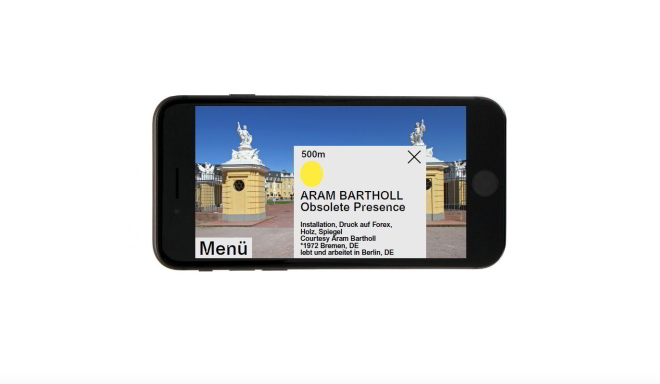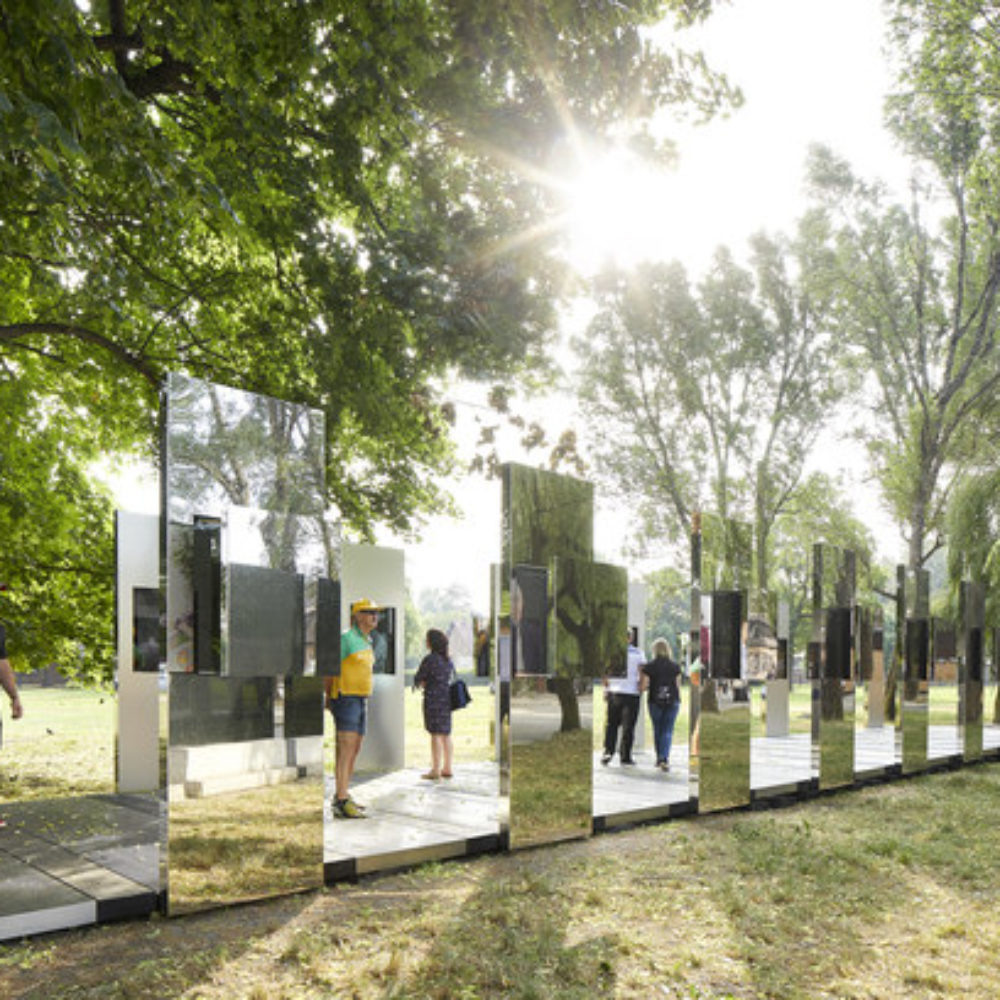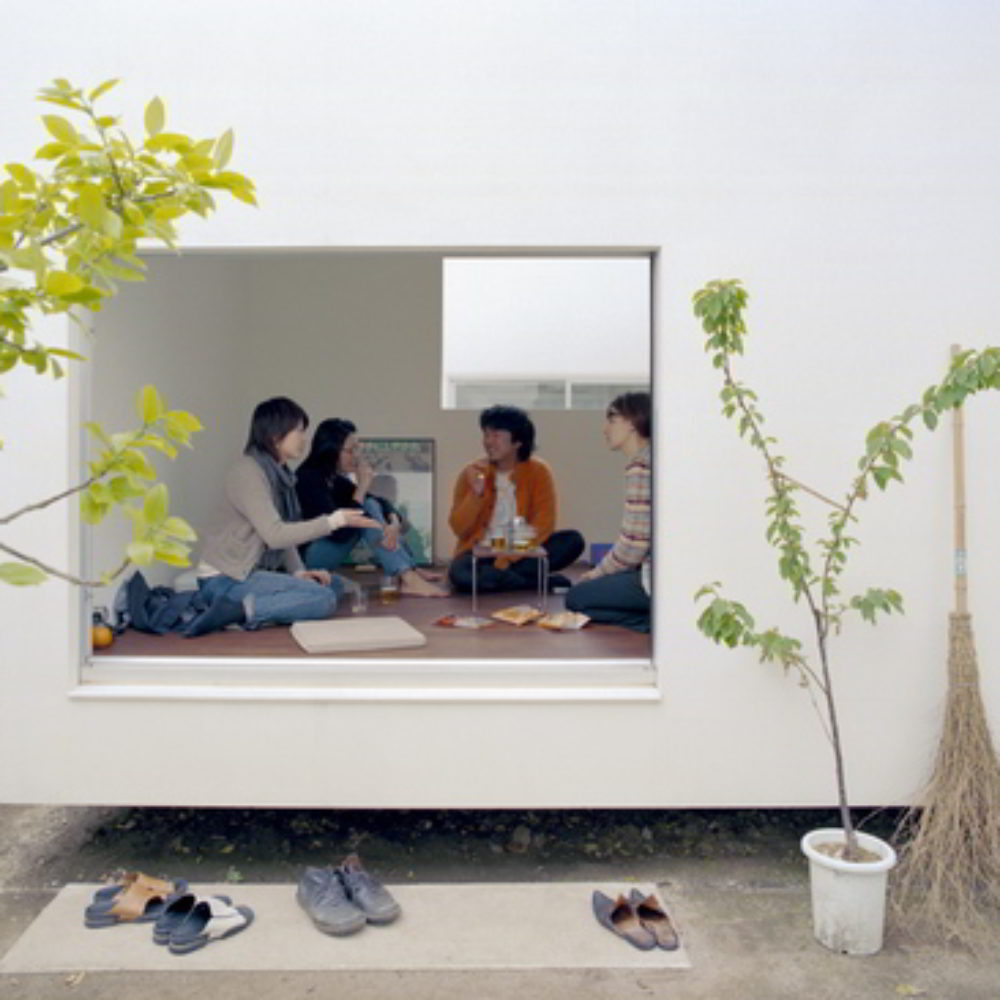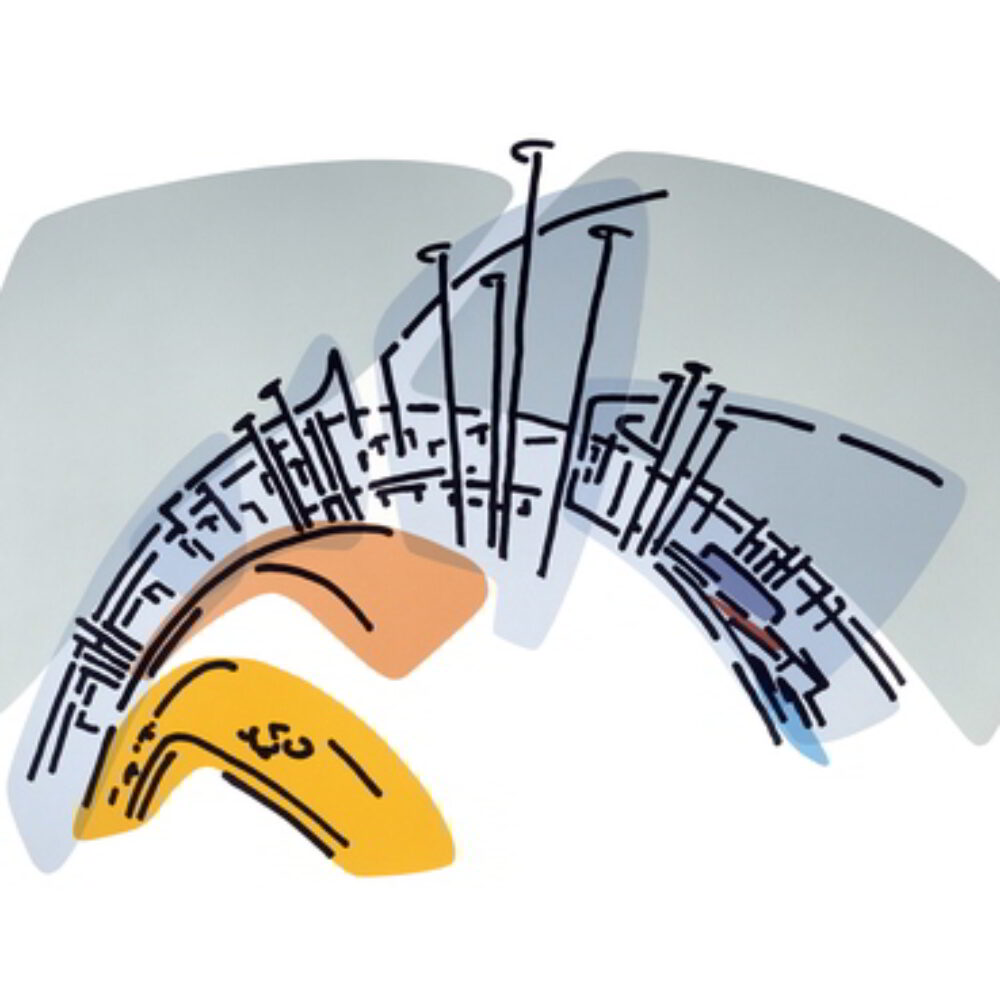Feierlich-funkelndes Fassadenlichtspiel, Selfie-artiges Monument, Muster-beamende Fahrräder, auf Interaktion getrimmte Scheinwerfer: All das gehört zum Programm der Seasons of Media Arts. Das Medienkunstfestival der Stadt Karlsruhe und des ZKM findet statt im gesamten städtischen Raum vom 11. September bis Dezember 2020 und 2021 hinein.
27. November 2020 | Özlem Özdemir
V
or fast genau einem Jahr gab das Kulturamt von Karlsruhe einen Beschluss der UNESCO bekannt: Karlsruhe ist erste deutsche Creative City of Media Arts und damit Teil des weltweiten Netzwerks der UNESCO Creative Cities. In diesem Rahmen präsentiert das Kulturamt zusammen mit dem Zentrum für Kunst und Medien (ZKM) ab dem 11. September bis Dezember 2020 – coronabedingt teilweise darüber hinaus – das Medienkunstfestival Seasons of Media Arts 2020. Der Ausstellungsort ist nichts Geringeres als der gesamte urbane Raum.
Karlsruhe zählt zu den jüngeren Städten Deutschlands. Mit der Grundsteinlegung für ein neues Schloss namens Carols Ruhe im Jahre 1715 begann ihr Aufbau inmitten unerschlossener Natur. Ihren Beinamen „Fächerstadt“ verdankt sie den rund 30 Alleen, die vom Schloss aus in Richtung der heutigen Stadt verlaufen.
Und genau zu diesem Bild des Fächers passt auch das breite und vielseitige Spektrum, das sich dem Publikum von Seasons of Media Arts bietet: Video-, Sound- und Lichtinstallationen, Projektionen an Fassaden und Straßen, künstlerische Interventionen und experimentelle Veranstaltungen von internationalen und lokalen Medienkünstlern, Karlsruher Initiativen und Institutionen. Zu den Schwerpunktthemen gehören etwa die Klimakrise oder die Demokratie im Zeitalter sozialer Medien.
Die gezeigten Werke ordnen sich punktuell im Zirkelschlag und den Achsen von Karlsruhe an und gehen von diesem Idealstadtbereich in die restlichen Stadträume über. Den Kopf bildet gleichsam eine Arbeit inmitten des Schlossgartensees – sozusagen der Quelle, des Entstehungsgrunds von Karlsruhe. Aram Bartholl, ein Medien- und Konzeptkünstler aus Berlin, liefert hier ein herausragendes Objekt im wahrsten Sinne des Wortes: Eine überdimensionale Hand, die ein etwas schräg gestelltes Smartphone umfasst oder hochhält oder: der Umgebung entgegenstreckt. Sein Titel: Obsolete Presence. Die 200×240 cm große Installation wurde in einer Ausstellung des Kunstvereins Arnsberg im Juni 2017 uraufgeführt. Es besteht aus einem Vierfarb-Druck auf einer Forex-Platte und Holz. Das Display wird dargestellt von einem Spiegel.

Bei Obsolete Presence liegt die Ironie auf (hier: vor) der Hand. Das heißt: Der touristische Impuls des Smartphone-Zückens ist einkalkuliert. Das Publikum wird sich nicht verkneifen können, dieses Ausstellungs- und Fotoobjekt aufzunehmen und dabei selbst zum Objekt zu werden und (hoffentlich) über die Situation nachzudenken oder gar zu meditieren (wenn auch höchstwahrscheinlich mit einer „Nicht-Ohne-Mein-Smartphone-Haltung“). Mögliche Fragen wären: Was oder wer ist an dieser Stelle „obsolet“ – also „überflüssig“ oder „nicht mehr gebräuchlich“? Was könnte „Präsenz“ in Zeiten der Medienherrschaft und -verliebtheit überhaupt (noch) bedeuten? Wer ist hier Objekt und wer Subjekt? Auffällig ist außerdem, dass der Künstler sich dafür entschied, das flache Smartphone in eine genauso flache Hand zu legen – beide liegen auf derselben Ebene. Schließlich hätte das technische Instrument auch in einer skulptural geformten Hand liegen können. Machen die Medien, die vor lauter grenzenlosen Angeboten und Möglichkeiten fast aus den Nähten platzen, den Nutzer doch irgendwie „eindimensional“? Verschmilzt er allzu sehr mit seinem technologischen Helfer und geht dabei fast unter? Denn auch so herum könnte man diesen schildartigen und bildhaften Gegenstand lesen: Er taucht auf, versinkt aber auch und mit ihm, das was ihn hält. Diese und ähnliche Überlegungen und Verdachtsmomente könnten im Schlosspark aufkeimen. Bartholl wäre also ein sehr guter Ausgangspunkt. Aber das Programm ist weit verstreut und ansetzen können die Festival-Besucher überall.

Gefasst sein sollte man zum Beispiel jederzeit auf Jonas Denzels Beitrag, besonders wenn es dämmert und dunkel ist. Sein Projekt beambike (2018) lässt sich an mehreren Stätten der Stadt auffinden. Der Karlsruher Filmemacher und Projection-Mapping-Künstler hat ein E-Lastenfahrrad mit mobiler Projektionstechnik präpariert. Verschiedene Objekte der Stadt – potenzielle Kandidaten sind Bäume, Brücken, Statuen – werden zu Projektionsflächen für Muster aus Augen und Händen und Farben.

Besonders eng mit Karlsruhe und dem ZKM verbunden ist Walter Giers. Der 2016 verstorbene Licht-, Klang- und Medienkünstler und Pionier der Electronic Art erhält einen Ehrenstandort: den ZKM Neubau am Platz der Menschenrechte. Die Lichtinstallation Funkelnder Kubus spielt mit dem würfelartigen Baukörper des Museums. Interessanterweise ist sie eine Rekonstruktion einer Arbeit aus den 1990er-Jahren; damals war sie am Turm des Stuttgarter Hauptbahnhofs zu sehen. Der Künstler verwendet Stroboskoplampen, die bekannt sind von Discos, Flugzeugtragflächen, Warnlichtern auf Straßen. Beim ZKM lassen sie seine gläserne Fassade punktuell und zeitversetzt aufblitzen und verwandeln den Bau in eine von Licht durchzuckte, visuell vibrierende, brillantartige Skulptur.

Auch Marie Sesters ACCESS gehört zu den Werken, deren Premieren weiter zurückliegen. Die Arbeit der französisch-amerikanischen Künstlerin aus New York entstand bereits 2003, entwickelte sich seitdem (je nach Geschmack) zu einem Publikumsliebling oder auch -verstörer. Ab 2021 wird sie in Karlsruhe wiedererweckt. ACCESS wirkt zunächst unscheinbar, fast versteckt. Eine im belebten öffentlichen Raum angebrachte Kamera registriert automatisch die Bewegungen der Menschen. Dann der entscheidende Moment: Ein Computer pickt eine Person heraus und erfasst sie mit einem Lichtkegel, der ihr daraufhin folgt. Bald kann man nicht mehr unterscheiden, wer von wem nicht mehr loslassen kann, Technik oder Mensch. Begleitet wird diese Jagdszenerie von gesprochenen Worten, die sich dem „Auserwählten“ widmen. Zum Einsatz kommen dabei robotergestützte Scheinwerfer und ein akustisches Beamsystem. Marie Sester geht es in ihrer interaktiven Kunstinstallation um unsere Besessenheit rund um Überwachung und Kontrolle (Stichwort: Tracking), Sichtbarkeit und Prominentsein im Internet. Ort und Laufzeit von ACCESS wird noch bekannt gegeben.
Zu den weiteren Installationen gehören u. a.: Light Signs (Betty Rieckmann) im Hauptbahnhof, Vortext (Michael Bielicky, Kamila B. Richter, Alex Wenger) im KOHI-Kulturraum, PhonoLuxMaschine (Didi Müller, Holger Förterer, Marc Teuscher) im Foyer der Kinemathek und GREEN CODE (Sabine Schäfer, Ulrich Singer) im Zoologischen Stadtgarten. Ob unter freiem Himmel oder in geschlossenen urbanen Zonen: Seasons of Media Arts 2020 lädt nicht nur zum Betrachten und Reflektieren, sondern auch zum Mitwirken ein: beim Flanieren und Passieren, in Gärten und an Gebäuden, mit Entdeckerlust und Spielfreude.
Für Deutschland ist all das nicht die erste und einzige Kunstinitiative im öffentlichen Raum. Dennoch: Verwandte Veranstaltungen von ähnlicher Qualität sind meist nur sporadisch anzutreffen. (Lichtparcours Braunschweig gehört zu den raren Beispielen.) Doch mit Hilfe der UNESCO wird sich dieses im Jahresrhythmus geplante und seit 2019 erstmals realisierte Kulturprojekt als internationales Ereignis etablieren. Nicht zu vergessen ist: Karlsruhe ist aus historischer Sicht eine junge Stadt. Anfang des 18. Jahrhunderts war sie aus einem Wald heraus entstanden. Ihre urbanen Gene sind von Anfang an günstig, sie scheint prädestiniert zu sein: für das Offene und für neue Entwicklungen, für Technologie oder Ästhetik. Und dabei geht es speziell bei dem diesjährigen Festival fast nicht mehr nur um die besagten Themen wie Klima und Demokratie. Denn allein dass sie 2020 stattfindet – und damit in Zeiten einer globaler Pandemie, in einer Periode, in der Außenraum, Digitalisierung und Interaktionen mit anderen Augen gesehen werden – ist ein zu bedeutungsvoller Zufall und eine fast tragische Gelegenheit. Es ist eine „merk-würdige“, es ist eine „congeniale Saison“ für Seasons of Media Arts. ♦

Zur Website von
ZKM | Zentrum für Kunst und Medien
Mapping, Tracking, Coding – Seasons of Media Arts 2020 in Karlsruhe
A solemnly sparkling façade lighting, a selfie-like monument, bicycles beaming with patterns, spotlights trimmed for interaction: all this is part of the program of the Seasons of Media Arts. The media art festival of the city of Karlsruhe and the ZKM will take place throughout the urban space from September 11 to December 2020 and 2021.
Almost exactly one year ago, the Cultural Office Karlsruhe announced a UNESCO resolution: Karlsruhe is the first German Creative City of Media Arts and thus part of the worldwide network of UNESCO Creative Cities. Within this framework, the Cultural Office, together with the Zentrum für Kunst und Medien (ZKM), will present the media art festival Seasons of Media Arts 2020 from September 11 to December 2020 – partly beyond that date due to corona. The exhibition venue is nothing less than the entire urban space.
Karlsruhe ranks among the younger cities in Germany. With the laying of the foundation stone for a new chateau called Carols Ruhe in 1715, its construction in the middle of untapped nature began. It owes its nickname „fan-shaped city“ to the approximately 30 avenues that run from the castle in the direction of today’s city.
And it is precisely this image of the fan that is matched by the broad and varied spectrum that Seasons of Media Arts offers its audience: video, sound and light installations, projections on facades and streets, artistic interventions and experimental events by international and local media artists, Karlsruhe initiatives and institutions. Among the main themes are the climate crisis and democracy in the age of social media.
The shown pieces are arranged pointwise in the compass arc and along the axes of Karlsruhe and merge from this ideal city area into the remaining urban spaces. The head is formed by a work in the middle of the Schlossgartensee, that is the source, the reason for the creation of Karlsruhe. Aram Bartholl, a media and conceptual artist from Berlin, provides here, quite literally, an outstanding object: an oversized hand that embraces or holds up a somewhat slanted smartphone or: stretches it out towards the surroundings. Its title: Obsolete Presence. The 200×240 cm large installation had its premiere in an exhibition of the Kunstverein Arnsberg in June 2017. It consists of a four-colour print on a Forex plate and wood. The display is represented by a mirror.
In Obsolete Presence, the irony is right at hand, here: in front of the hand. That means: the touristic impulse of the smartphone-whip is taken into account. The audience will not be able to resist shooting this exhibition and photo object and becoming an object itself and (hopefully) thinking about the situation or even meditating on it (though most likely with a „Not-Without-My-Smartphone-Attitude“). Possible questions might be: What or who is „obsolete“ at this point – i.e. „superfluous“ or „no longer common“? What could „presence“ even (still) mean in times of media domination and infatuation? Who is the object and who subject here? It is also striking that the artist chose to place the flat smartphone in an equally flat hand – both are on the same level. After all, the technical instrument could also have been embedded within a sculptural hand. Do the media – almost bursting at the seams with their boundless offerings and possibilities – make the user somehow „one-dimensional“? Does the user melt too much into his technological assistant and almost disappear in the process? Because even this way around, one could read this sign- and image-like item: It emerges, but also sinks, and with it, that which holds it. These and similar considerations and suspicions could arise in the palace park. Bartholl, therefore, would be a good starting point. But the program is widely scattered, and festival visitors can start anywhere.
You should always be on the lookout for Jonas Denzel’s contribution, for example, especially at dusk and in the dark. His project beambike2018 covers several locations in the city. The Karlsruhe filmmaker and projection-mapping artist has prepared an electric bike with mobile projection technology. Various objects of the town – potential candidates are trees, bridges, statues – become projection screens for patterns of eyes and hands and colours.
Walter Giers has particularly close ties to Karlsruhe and the ZKM. The light, sound and media artist and pioneer of electronic art, who died in 2016, receives a place of honour: the ZKM new building at the Platz der Menschenrechte. The light installation Funkelnder Kubus (Sparkling Cube) plays with the box-like structure of the museum. Interestingly, it is a reconstruction of a work from the 1990s; at that time it was on display on the tower of Stuttgart’s central station. The artist uses stroboscope lamps, known from discos, aeroplane wings, warning lights on streets. At the ZKM, they make his glass façade flash, point-by-point and time-delayed, and transform the building into a visually vibrating, brilliant sculpture palpitating with light.
Marie Sester’s ACCESS also belongs to the works whose premieres are further back in time. The work of the French-American artist from New York was already developed in 2003. Since then it has become either a darling of the public or a public disturbance – depending on taste. From 2021 it will be revived in Karlsruhe. ACCESS seems inconspicuous at first, almost hidden. A camera installed in the busy city space automatically registers people’s movements. Then comes the decisive moment: a computer picks out a person and captures him or her with a cone of light that subsequently follows the subject’s movements. Soon it is no longer possible to distinguish who can no longer let go of whom, technology or human being. This hunting scene is accompanied by spoken words dedicated to the „chosen one“. The set of tools consist of robot-supported spotlights and an acoustic beam system. Marie Sester’s interactive art installation revolves around our obsession with surveillance and control (tracking), visibility and celebrity on the Internet. Location and duration of ACCESS are to be announced.
Other installations include Light Signs (Betty Rieckmann) in the central station, Vortext (Michael Bielicky, Kamila B. Richter, Alex Wenger) in the KOHI-Kulturraum, PhonoLuxMaschine (Didi Müller, Holger Förterer, Marc Teuscher) in the foyer of the Kinemathek and GREEN CODE (Sabine Schäfer, Ulrich Singer) in the Zoologischer Stadtgarten. Whether under the open sky or in closed urban zones: Seasons of Media Arts 2020 not only invites you to view and reflect but also to take part: when strolling and passing by, in gardens and on buildings, with a desire for discovery and the joy of playing.
For Germany, all this is not the first and only art initiative in public space. Nevertheless: Related events of similar quality usually occur only sporadically. (Lichtparcours Braunschweig is one of the rare examples.) But with the help of UNESCO, this cultural project, planned with an annual rhythm and realized for the first time since 2019, will establish itself as an international event. Not to be forgotten: Karlsruhe is a young city from a historical perspective. At the beginning of the 18th century, it was born out of a forest. Its urban genes have been favourable from the beginning; it seems to be predestined: for openness and new developments, for technology or aesthetics. And this year’s festival, in particular, is almost no longer just about the already mentioned themes such as climate and democracy. For the mere fact that it is taking place in 2020 – and thus in times of a global pandemic, a period in which outdoor space, digitalization and interactions are seen with different eyes – is too meaningful a coincidence and an almost tragic opportunity. It is a “ note-worthy „, it is a „congenial season“ for Seasons of Media Arts.
TRANSLATION BY ÖZLEM ÖZDEMIR






